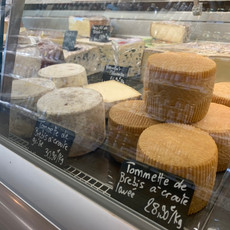The Southern French Alps: Day One, Les Deux Alpes
- Jul 1, 2019
- 4 min read
Updated: Jul 2, 2019
Early in 2019, I had decided that the week of July 4thof this year would be a good time to grasp the opportunity to travel to France: the country that inspired the American revolution, and its independence and the creation of the Great Experiment of democracy, as we know it today.
The fact that at the time, I was deeply engrossed in Jon Meacham’s biography of Thomas Jefferson, perhaps was partly responsible. Also, being a keen cyclist, I had always wanted to explore the French Alps, and with friends living in Les Deux-Alpes, and a race held around that very area of the Alps on July 10th, I could see that everything was converging.
Les Deux Alpes is a small village in Les Alpes Sud, the Southern French Alps. To the north is L’Alpe d’Huez, the Northern Alps and eventually Geneva. To the West is Grenoble, and the Rhone-Alpes. To the East is the Savoie and the Italian Piedmont, with Turin and Milan, being only an hour away by car.
At around 1600m, it is quite firmly in the mountains: it is a big ski resort in the winter, and a major downhill mountain bike resort in the summer. Although, it's the beginning of July and there are still skiers and snowboarders around, because the glaciers above, still have snow. So, right now you will see a skier, a snowboarder, a mountain biker, a cyclist and a hiker all in the same village. Very weird.
There are cows up on the mountains, though few in number. And since there is no dairying locally, the cows have 2 roles; grow strong for beef, and to chew the grass down. This second role is vitally important to the town: if the grass is short, the snow sticks to the slopes, so you can ski, and importantly, there are no avalanches. If there are no cows, there is long grass, the snow slides down, and all of a sudden there's no Les Deux Alpes.
Les Deux Alpes is also a meeting point of some significant food culture: with the Savoie, the Rhone Alpes, Grenoble, and the Jura all within striking distance of the area, providing Tomme de Savoie, Beaufort, Tarte aux Noix, and Reblochon fresh to the area.
But before the fun food investigations can start, there is the business of prepping for the race in Sunday. Some climbing on the bike. I flew my bike over with me, and spent 30 mins rebuilding it, before heading out on the first ride of the trip: a warm up of around 50 km/35 miles. Cruise down Les Deux Alpes, ride along the valley, before starting the first few switchbacks of the Alpe d'Huez, but peeling off onto a side road to ride back towards the bottom of Les Deux Alpe, and back up to base. I noticed the rich diversity of wild flowers and grasses on the side of the roads, and in the meadows. So it's unfortunate that, unlike in Switzerland, no cheese is made from grazing animals in this valley, because I'm sure that they would make complex and flavorful cheeses.
There has been a heatwave in Europe over the past week, which is finally breaking, but the temperature in the valley was toasty: 33 C/98 F, but the climbs were warm but manageable. After 2 hours of riding and 1500 m of climbing, the first leg spin out was complete, and it was time to find some lunch!
We managed to catch the local restaurant before they settled in for their siesta, and after a light salad, gallete maxi (meat crepe), the cheese and charcuterie board came out. Prosciutto di Parma, Speck, Jambon de Paris, salami and bresaola, were combined with a little chevrot, some Beaufort and a simply wonderful tomme de Savoie. Not only did it taste quite lovely, I was able to geek out a bit at the wonderful combination of rinds on display!
After lunch, it was cheese shop time: across the road was the imaginatively named La Fromagerie Les Deux Alpes, where cheese for dinner was picked. There was a pretty good display, with a majority of harder cheeses, and only a few soft cheeses, but all French, not even an Italian cheese.
In the end, the choice was conservative, with a local favorite thrown in: a massive chunk of Beaufort, 1/2 a Tomette de Brebis (think Ossau Iraty, but sightly drier), some ashed and 'blanc' aged goat buttons, and then a local blue, Bleu de Sassenage, which was locally handmade on a farm, with rich milk (the soft squishy yellow paste!) and rustic, grassy and cow-y taste, which is unmistakenly French.
One interesting aspect of this cheese shop was its 'aging cave': simply a room where they put wheels of Beaufort and Comté, which they buy slightly young, and age them between 10 & 15 C, at high humidity (controlled amusingly by a mister you'd find in a bedroom!).
It'd been a long day, and with little sleep. I was already starting to think with anticipation on tomorrow's attempt on Le Galibier, the Women's World Cup Semi Final, and Tartiflette for dinner…
Early in 2019, I had decided that the week of July 4th of this year would be a good time to grasp the opportunity to travel to France: the country that inspired the American revolution, and its independence and the creation of the Great Experiment of democracy, as we know it today.





















Comments